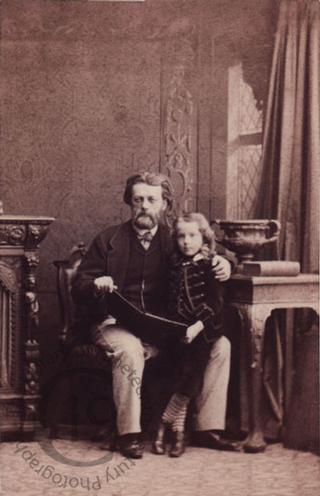
Frederick Lehmann and his son
A carte-de-visite portrait of the British businessman and Liberal politician Frederick Lehmann (1836-1891), seen here with his eldest son Rudolf Chambers Lehmann (1856-1929).
(Augustus) Frederick Lehmann, FRGS, was a British businessman and Liberal Party politician. He was born in Hamburg, the son of painter Leo Lehmann of Hamburg, who numbered Liszt and Ingres among his friends. His brothers were the artists Henri Lehmann and Rudolf Lehmann.
Lehmann stood unsuccessfully for parliament at Middlesex in 1874 and Waterford in 1877. He was elected as the MP for Evesham at a by-election in July 1880, by a majority of only two votes. However, a petition was lodged and the result voided. Scrutiny of the votes led to his opponent Frederick Dixon-Hartland being declared the winner in January 1881, with a majority of only one vote.
Lehmann married Nina Chambers, daughter of Dr Robert Chambers of Edinburgh. Their social circle included Charles Dickens, George Eliot, Robert Browning, Lord Leighton, and other prominent figures. Their son Rudolf Chambers Lehmann was also a politician.
The couple appear on the 1861 census, living at 139, Westbourne Terrace, Paddington. Lehmann gave as his profession ‘Iron Merch[ant] & Steel Manufacturer’. [He apparently made a fortune during the American Civil War supply arms to the government army.] Also present on the night of the census were their sons: Rudolf (5), Frederick (3) and Ernest (1), as well as a German governess and five servants.
The family later lived at 15, Berkeley Square, Mayfair. George Aitchison, architect of Leighton House, redesigned the drawing room and other parts of the house for them.
Frederick Lehmann died on 22 August 1891, aged 65.
The child with him in this portrait is his eldest son, Rudolf Chambers Lehmann (1856-1929), later a Liberal politician – he sat in the Commons from 1906 to 1910 – and a major contributor to Punch magazine. The novelist Rosamond Lehmann was his daughter.
Photographed by Camille Silvy of London on 28 July 1862.
Code: 125877




